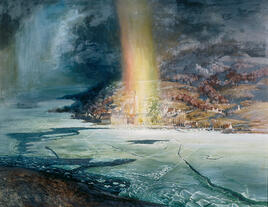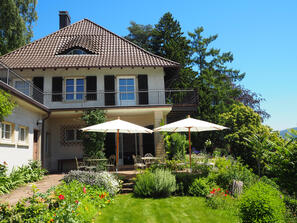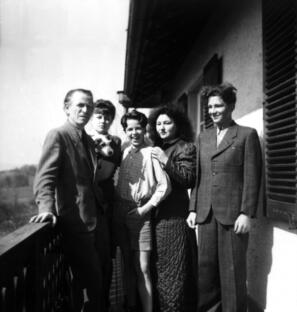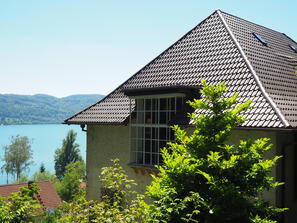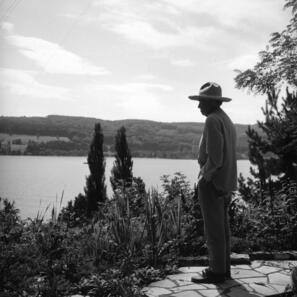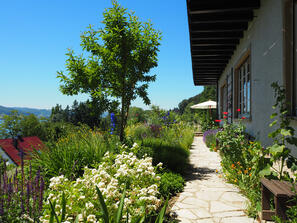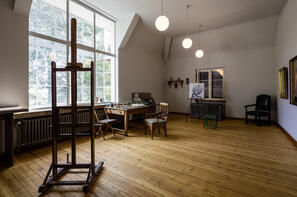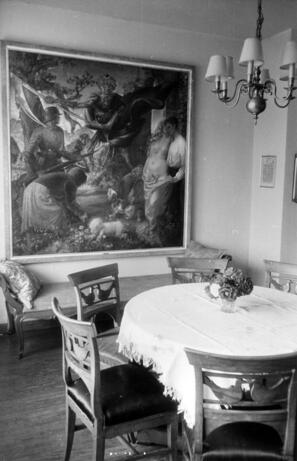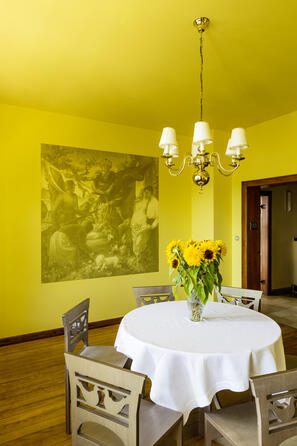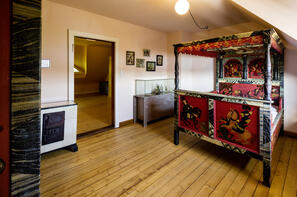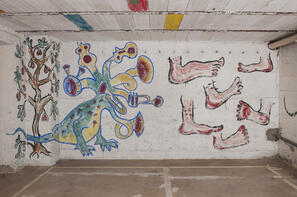Museum Haus Dix
In the Footsteps of an Artist Family
At the Museum Haus Dix visitors can experience the everyday life of an artist family in the postwar period. Here, in the former studio and residential house overlooking Lake Constance lived the artist Otto Dix, together with his wife, Martha, and their three children from 1936 until his death, in 1969. A media guide leads visitors through the rooms with their histories, which remain fascinating today. The idyllic garden with its several terraces and the museum café invite you to linger.
From Dresden to Lake Constance
Born in Untermhaus (now a district of Gera), Otto Dix is considered one of the most important artists of the twentieth century and became a leading exponent of the New Objectivity in the 1920s. When the National Socialists came to power, in 1933, his work was denounced as degenerate. Dix also had to give up his professorship at the Dresden Academy of Fine Arts. But leaving the country was out of the question for him: "How could you emigrate when you have a stable full of pictures here? The Nazis would have come and confiscated everything. That would have been simply unacceptable!"
Instead, the family relocated to Randegg in 1933. In 1936 they moved into their newly built house in Hemmenhofen—in close proximity to the neutral Swiss shore. This break in Dix's life also had an impact on his artistic work. While his art had previously been characterized by subjects such as war and the metropolis, Dix increasingly devoted himself to the landscape around Lake Constance in his works.
"A beautiful paradise. Beautiful enough to make you puke. I’m standing in front of the landscape like a cow."
Otto Dix
The Residence
Thanks to an inheritance, Martha Dix was able to acquire the property in what was even then a prime location. The spacious house was designed by the Dresden architect Arnulf Schelcher. Its characteristic features include the studio window on the east side, the wrap-around balcony, and numerous windows overlooking the lake.
The interior of the house is divided into three stories: the kitchen along with the living, dining, and music rooms are located on the ground floor. Otto Dix's studio and Martha Dix's salon are found on the second floor, and on the third floor are the rooms that belonged to the couple's children, Nelly (1923–1955), Ursus (1927–2002), and Jan Dix (1928–2019).
During guided tours visitors can also view the basement; its walls were painted by Dix and a few of his guests during a carnival party in 1966. The motifs show figures from the Alemannic carnival, or "Fastnacht," but also caricatures of friends and famous people. The wall paintings were long hidden behind bookshelves and first rediscovered in the course of extensive restoration work done in December 2012.
The Museum Haus Dix Concept
For the renovation of the house in accordance with monument-preservation specifications, a special type of reconstruction was developed that both recreates this historical site and brings the history of the era and its art to life. Paintings and graphics are presented in annually changing exhibitions. Reproductions on the walls stand in for works that once hung in the family’s living area and are now scattered around the world in museums and private collections. To convey the temporal distance from the present, the images appear as if they had left an imprint on the wall.
A media guide accompanies visitors through the house and the garden. It provides information on works of art and Dix family life and recounts personal anecdotes from Jan Dix.
The house and garden were registered in the monument registry of the State of Baden-Württemberg in 2005. In 2010 the Otto-Dix-Haus Foundation had the ensemble restored in accordance with monument-preservation standards and equipped for museum operation. In 2013 the foundation transferred it to the Kunstmuseum Stuttgart, which holds one of the world's leading collections of works by Dix.
Museum Haus Dix
Otto-Dix-Weg 6
78343 Gaienhofen-Hemmenhofen
+49 (0)7735 / 93 71 60
dix [at] kunstmuseum-stuttgart [dot] de (dix[at]kunstmuseum-stuttgart[dot]de)
Opening Hours
Wed to Sun 10 am–5 pm
Mon closed
Tue on request for groups
The season ends on 10/31/2024
Admission
6 € / 4 €
Children and young people (ages 6–14) 2 €
Family 12 €
Mettnau-Card 4 €
Bodensee Card West 5 €
On presentation Ticket Kunstmuseum Stuttgart 5 € / 4 €
Combi Ticket Hesse-Dix (Hesse Museum Gaienhofen / Museum Haus Dix) 9 € / 6 €
Free admission: ICOM, Deutscher Museumsbund, Förderverein Museum Haus Dix und Freundeskreis Kunstmuseum Stuttgart
Tours (in German)
Every 2nd and 4th Sunday, 2 pm and 3.30 pm
€ 2.50 / € 1.50 (plus admission)
Reservation is requested via +49 (0)7735 / 93 71 60 or dix [at] kunstmuseum-stuttgart [dot] de.
The basement can only be visited with a guided tour.
Free Mediaguide
available at the ticket desk
also downloadable in the museum as app
Präsentation 2024
»Innere Emigration«? Otto Dix und die politische Landschaft
Im Fokus der Präsentation stehen die in Bodenseenähe entstandenen Landschaftsgemälde von Otto Dix, von denen aus Verbindungslinien gezogen werden zum Ehepaar Dix und dem familiären Leben auf der Höri sowie zu den politischen Gegebenheiten.
Dix’ künstlerisches Wirken war ab 1933 unmittelbar durch die Anordnung der Nationalsozialisten zur Entlassung von seiner Professur für Malerei an der Dresdner Kunstakademie und die Verfemung seines Werks als »entartete Kunst« geprägt. Seine Hinwendung zu einer besonderen, politischen Landschaftsmalerei ist Thema der Präsentation im Atelier von Otto Dix. Der durch eine Erbschaft von Martha Dix ermöglichte Hausbau als Lebensmittelpunkt der Familie in Hemmenhofen und ihre Position als Bauherrin Mitte der 1930er-Jahre werden im Salon Martha Dix dargestellt.
Kuratiert wurde die Ausstellung von Dr. Ina Jessen, Kunsthistorikerin und Otto Dix-Expertin. Die Umsetzung erfolgte in Zusammenarbeit mit Dierk Höhne, Kurator am Kunstmuseum Stuttgart.
